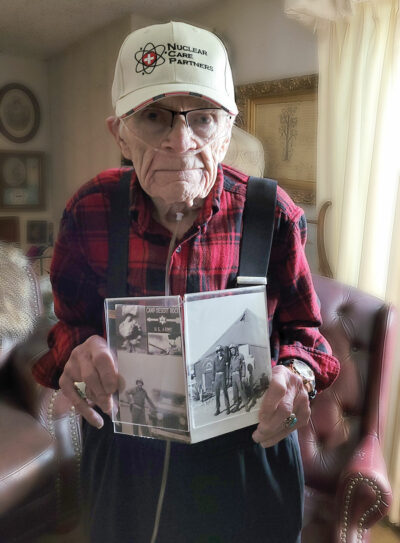Meet Fred

The Last Surviving Member of the Manhattan Project Bomb Test Crew
I’m proud to have worked for over 14 years in the atomic industry and am honored to be carrying out the legacy as the last surviving member of the Manhattan Project Bomb Test Crew. My name is Fred and I was born in Oklahoma City, Oklahoma in 1932 near the height of the Great Depression. At just three days old, I was adopted by my wonderful family for a mere ten dollars! My father worked for the Sinclair Oil Corporation so they brought me out to Shidler, Oklahoma where I grew up on the oil lease. I was blessed with a great family and upbringing, and I was even fortunate enough to meet and have a relationship with my birth parents later in life. My dad’s job had us moving around between Oklahoma and Kansas depending on where the oil company needed him and in my senior year of high school, he was transferred to Claflin, Kansas.
After graduating high school I began working in Wichita, Kansas for Boeing as an Expediter. Shortly after I was drafted and though it broke my dad’s heart, they sent me to basic training in Camp Hope, Louisiana. After completing basic training, I was sent to guard the Presidio of San Francisco in California. I thought I would eventually be going to Korea for the war but there was a secret mission assigned to me that they wouldn’t tell anyone about, not even me! As a part of this secret mission, myself and some other military policemen were sent to Area 51 and the Nevada Test Site. They finally told us that we were to be a part of Operation Upshot–Knothole, setting off 11 atomic tests throughout the summer.
I couldn’t believe how developed the Nevada Test Site, then called the Nevada Proving Ground, was. It was almost like a city. They started building homes and businesses and even brought in cattle and sheep. While working there, my job as a military policeman was to escort all of the military troops who arrived at the test site to witness the bomb tests. I would advise them, “There’s going to be a test going off in a few minutes. You’re going to have to get down in the trench, and don’t get up! Wear your dark glasses, then once the wind comes you can stand up.” After each test, the other military policeman and I would go back to our tents and sleep during the day while the debris continued to rain down from the sky. The protection wasn’t great, we hardly wore any radiation badges because we didn’t know what we were being exposed to at the time. In hindsight, many of us workers should’ve been in the trenches while the tests were going off rather than staying above ground at the Jeeps. Who knows what we were exposed to!
After the military, I began working at the Los Alamos National Laboratory in New Mexico. I started in 1956 and worked for LANL for 14 years. I was working full-time in security and part-time in the lab, helping build the core of the bombs in the hot boxes.
While working at Los Alamos, I got the opportunity to see and meet some of the most famous theoretical physicists like Albert Einstein and J. Robert Oppenheimer. I witnessed and was a part of some incredible parts of history there. Years later, my security job began to fold and the lab wanted to hire me full-time but I really didn’t want to work there for the rest of my life so I turned it down. “It’s a good thing he did because all of his buddies are gone now from working there full-time,” said Fred’s wife Gloria.
I left Los Alamos in 1970 and my family and I eventually moved up to Canada for a bit where I worked in air traffic control for the Calgary International Airport. One day we got a call from the Atomic Testing Museum being built in Las Vegas. They told us that they were raking the country to find people who worked with the atomic tests and I was the first surviving member that they had found.
They invited us to the museum opening and asked if we’d like to come down early to see the old atomic proving grounds. We couldn’t say no! So we went down in November of that year and from the hotel, we took a bus to the proving grounds. “The bus was full of descendants of the workers that had passed, but not any of the original workers, other than Fred,” Gloria remembered. “It was a very rainy day and when we finally got to the grounds where the bombs had been they had had so much rain that Fred didn’t recognize it because it was all covered in grass!”
We were asked to come back to the museum opening that following February and they made all of the arrangements for us. Before the opening, we sent them some old things of mine to include in the museum—photos of myself, my Camp Desert Rock mess card and unit insignia, and photographs and information about Operation Upshot–Knothole. They even created a study collection in my name! Since working at the sites, I’ve been diagnosed with and added COPD, Asbestosis, and skin cancer to my DOL White Card. Thankfully, Nuclear Care Partners is there to help me every day. I’ve been cared for by them for nine years now and it’s been amazing. My wife, Gloria is also my family caregiver and was just tickled when she won Nuclear Care Partners’ Family Caregiver of the Year award in 2016!
To Read Fred’s Full Story, Check Out our Atomic Health News: Summer 2022 Edition!


